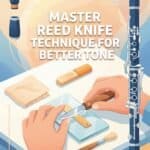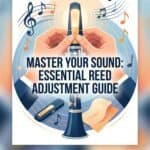How to cut a clarinet reed: Use a sharp reed knife or dedicated cutter, measure to a standard length of about 2.5 inches, remove an initial 1-2 mm from the tip, then smooth with fine-grit sandpaper. Test the reed on your mouthpiece and repeat very small adjustments until the response, tone, and articulation feel balanced.
What is clarinet reed cutting?
Clarinet reed cutting is the process of shortening and reshaping a reed to improve response, tone, and stability. Players remove a tiny amount of cane from the tip or adjust the profile of the heart and back. Done correctly, cutting can rescue slightly too-soft or too-long reeds and customize them for your mouthpiece and embouchure.
Reed cutting is different from simple sanding or breaking in. Cutting changes the actual length and tip geometry of the reed, often by 1-2 mm at a time. This small change affects vibration speed, resistance, and pitch stability. Skilled players and technicians use cutting to fine-tune reeds for orchestral, jazz, or solo playing without relying only on factory strength numbers.
Clarinet reed anatomy: tip, heart, back, and how each part affects sound
A clarinet reed has three main acoustic zones: the tip, the heart, and the back (or stock). Understanding how each area behaves helps you decide where and how much to cut or trim. Even a 0.1 mm change in thickness can noticeably alter response, especially near the tip.
The tip is the thinnest, most flexible part that actually starts the vibration. It is usually about 0.08-0.12 mm thick on many Bb clarinet reeds. A thinner, more flexible tip speaks easily at soft dynamics but can feel unstable or bright. A slightly thicker tip increases resistance and focus but may feel stiff if overdone.
The heart is the thicker central region behind the tip, often about 0.30-0.40 mm thick. It controls core, projection, and stability. A strong heart gives a dark, centered tone and secure high register, while a heart that is too heavy can make the reed feel stuffy or slow to respond. Cutting rarely shortens the heart, but trimming can reshape it.
The back or stock includes the heel and bark that sit on the mouthpiece table. It provides structural support and affects how the reed seals on the facing. Uneven thickness in the back can cause leaks or asymmetrical vibration. Cutting the reed shorter always happens at the tip, not at the heel, to preserve the table contact area.
Side rails and vamp shape also matter. The rails along the sides help define tone color and articulation clarity. Uneven rails can cause one side to vibrate more than the other, leading to a fuzzy or unstable sound. When cutting and trimming, always check that both rails are symmetrical and that the tip curve matches your mouthpiece facing.
Important tools and models (reed knives, manual trimmers, cutters, electric machines)
Effective clarinet reed cutting depends on sharp, predictable tools. The basic options include reed knives, manual trimmers, dedicated cutters, and electric or mechanical machines. Each tool type suits different experience levels and precision needs, from student adjustments to professional reed work.
A reed knife, such as those made by Flexcut or traditional double-bevel knives, offers maximum control. You can scrape, clip, and sculpt the tip and heart with subtlety. The tradeoff is a steeper learning curve and higher risk of gouging or uneven cuts if your hand is unsteady or the blade is dull.
Manual trimmers and cutters, including models inspired by classic Rico or Vandoren designs, use a guided platform and a cutting blade to remove a consistent slice from the tip. You place the reed against a stop, then press a lever to clip a precise amount. These are ideal for players who want predictable 0.5-1 mm cuts with less risk.
Electric or mechanical reed cutting machines are common in professional workshops and repair studios. These devices can adjust tip thickness, profile, and length with micrometer-level control. They are expensive and usually not necessary for most students, but they give makers and technicians repeatable results across dozens of reeds.
Supporting tools are just as important. A small metal ruler or digital caliper, a fine permanent marker, 400-1000 grit sandpaper, a glass or marble plate, and a good reed plaque help you measure, mark, and refine your cuts. A stable cutting board or bench surface keeps your hands safe and your cuts square.
Step-by-step reed cutting workflow (measure, mark, initial cut, refine, test) – include 1-2 mm and ~2.5″ references
A clear, repeatable workflow removes guesswork from clarinet reed cutting. The goal is to change only one variable at a time, in very small increments, while checking the reed on your own mouthpiece. This process works with cane reeds and, with care, some hybrid or adjustable synthetic models.
Step 1: Inspect and measure the reed
Start by checking the reed for cracks, deep chips, or warped bark. Discard reeds with serious structural damage. Measure the full length from heel to tip with a ruler. A typical Bb clarinet reed is about 2.5 inches long. Note the current length so you can track how much you remove.
Place the reed on a flat surface and gently press the tip against a reed plaque. Look at the tip curve relative to your mouthpiece facing. If the reed is significantly longer than your best reeds, trimming may help. If it is already shorter than 2.45 inches, be extremely conservative or avoid cutting entirely.
Step 2: Mark your cutting line
Use a fine permanent marker to draw a reference line across the tip. For an initial adjustment, mark 1 mm from the existing tip. For very soft reeds that you want to strengthen, you can mark up to 2 mm, but never remove more than that in a single cut. Symmetry and accuracy are more important than speed.
Align the reed on your cutting tool or cutting board so that the mark is parallel to the cutting edge. If you use a manual trimmer like a Rico-style cutter, adjust the stop so the blade will hit exactly at your mark. Double-check alignment from both sides to avoid cutting the reed crooked.
Step 3: Make the initial cut
With a manual trimmer or cutter, press the lever or blade in one smooth, firm motion. Avoid partial cuts or sawing motions, which can splinter the cane. If you use a reed knife, place the reed on a plaque and use a controlled slicing motion from one rail to the other, following your marked line.
After the cut, inspect the new tip edge. It should be straight, clean, and square to the rails. If you see fibers or tiny splinters, do not panic. These can usually be removed in the refining step with fine sandpaper or light scraping. Check the new overall length and record it in a notebook if you track your adjustments.
Step 4: Refine and smooth the tip
Place 600-1000 grit sandpaper on a flat glass or marble surface. Holding the reed flat, gently pull the tip across the paper with light pressure, moving from heel toward the tip. Use only 2-3 passes at a time. This polishes the cut edge and evens out minor irregularities without thinning the tip excessively.
Next, place the reed on a plaque and lightly scrape along the vamp with a sharp reed knife if needed. Work from the center toward each rail, avoiding deep cuts. Your goal is to blend the new tip edge into the existing profile so there is no abrupt step that could cause a harsh attack or buzzing.
Step 5: Test on the mouthpiece
Moisten the reed normally, then play long tones, scales, and simple articulation exercises at soft and medium dynamics. Pay attention to response in the low E-G region, throat tones, and clarion A-C. If the reed feels slightly more resistant but stable, your 1-2 mm cut likely succeeded.
If the reed now feels too hard, do not immediately cut more length. Instead, consider light scraping at the tip or thinning the heart slightly to rebalance resistance. If the reed still feels too soft or unstable, you can repeat the workflow, marking and removing another 0.5-1 mm, but stop if the length approaches 2.45 inches or lower.
Tip and heart shaping techniques for different tonal outcomes (beginners vs professionals)
Once you control basic reed cutting, you can use tip and heart shaping to tailor tone and response. The same 2.5 inch reed can feel very different depending on how you balance the tip flexibility and heart strength. Approach this conservatively if you are new to reed work, and keep one or two reference reeds nearby.
For beginners, focus mainly on evenness and easy response. After a small tip cut, use very light sanding or scraping to keep the tip thin and flexible. Avoid heavy work on the heart. A slightly thinner tip with a moderate heart gives a clear attack and easier high notes, which helps students build confidence and consistent embouchure.
For advancing and professional players, heart shaping becomes more important. A stronger heart with a slightly thicker tip can produce a darker, more focused tone and better projection in orchestral or big band settings. You can gently thin the sides of the heart while preserving a central spine to keep stability while freeing up articulation.
If you want a brighter, more flexible jazz sound, you might keep the heart a bit lighter and ensure the tip is very even from rail to rail. Small adjustments near the corners of the tip can improve altissimo response and fast articulation. Always work symmetrically and test after each small change to avoid over-thinning one side.
Remember that mouthpiece facing length and curve interact with your reed profile. A long facing often pairs well with a slightly stronger heart and carefully thinned tip. A shorter facing may need a more moderate heart to avoid feeling too stiff. Use your best-playing reed as a visual and tactile template when shaping others.
Tool comparison and buying guide (pros/cons: Rico, Flexcut, ReedGeek, electric cutters)
Choosing the right reed cutting and trimming tools depends on your experience, budget, and how many reeds you expect to adjust. Here is a practical comparison of common brands and tool types, including Rico-style trimmers, Flexcut knives, ReedGeek tools, and electric cutters used by some professional makers.
Rico-style manual trimmers are popular for their simplicity. You insert the reed, align it with a stop, and press a lever to clip a consistent amount from the tip. Pros include repeatable cuts and a gentle learning curve. Cons include limited flexibility for shaping the heart or rails and the need to match the trimmer to your reed size.
Flexcut and similar reed knives offer maximum versatility. A sharp, well-maintained knife can clip, scrape, and sculpt every part of the reed. This is the preferred tool for many professionals and repair technicians. The downside is that knives require skill, regular sharpening, and careful safety habits to avoid slips and uneven cuts.
ReedGeek tools are precision metal implements designed for scraping, flattening, and micro-adjusting reeds. They are not traditional cutters, but they excel at refining the tip, rails, and back after a cut. Pros include durability and control without sharpening. Cons are the initial cost and the need for practice to understand each edge and contour.
Electric or mechanical cutters, including some custom workshop machines, allow extremely precise adjustments in length and profile. These are best suited to reed makers, repair technicians, or professionals who process large numbers of reeds. They are expensive and overkill for most students, but they can produce very consistent results across a box.
For most players, a practical starter kit includes a reliable manual trimmer, a basic reed knife or ReedGeek, fine sandpaper, and a good reed plaque. As your skills grow, you can add higher-end knives or consider professional-grade trimmers. Always prioritize sharpness and stability over gadget complexity.
Maintenance and care for finished reeds (storage, re-hydration, sanding)
After cutting and trimming, proper reed maintenance keeps your work stable and extends reed life. Cane is a living material that reacts to moisture and temperature, so your storage and re-hydration habits matter as much as your cutting technique. A well-maintained reed can serve reliably for many hours of playing.
Always let reeds dry flat on a glass or acrylic surface for 15-30 minutes after playing. Then store them in a ventilated reed case that supports the back and protects the tip. Cases with a flat glass or acrylic plate help keep the reed table stable, which preserves your carefully adjusted length and profile.
Before playing, gently re-hydrate the reed by soaking the tip in clean water for 30-60 seconds or by moistening it in your mouth for a minute. Avoid over-soaking, which can swell the fibers and temporarily undo your fine adjustments. Many players find that a light water soak gives more consistent results than saliva alone.
Periodic light sanding can refresh the surface and remove mineral buildup. Use 600-1000 grit sandpaper on a flat plate, and make only a few passes from heel to tip with minimal pressure. This keeps the tip edge clean after repeated playing and helps maintain a smooth attack without significantly thinning the reed.
Revisit your reeds every few days of playing to check for warping or changes in response. Slight warping can sometimes be corrected with gentle flattening on glass or by using a ReedGeek on the back. If a reed requires constant heavy correction, it may be time to retire it and focus your efforts on more stable pieces of cane.
Troubleshooting common problems (splintering, buzzing, weak high register, uneven response)
Even careful clarinet reed cutting can lead to issues if the cane is inconsistent or the adjustments are unbalanced. Recognizing the symptoms and linking them to specific causes helps you correct problems quickly or decide when to stop working on a reed and move on to another.
Splintering at the tip usually comes from a dull cutter, sawing motions, or cutting too much at once. The fix is to sharpen or replace the blade, reduce each cut to 0.5-1 mm, and smooth the edge with fine sandpaper immediately after cutting. If splinters extend deep into the vamp, the reed is often not worth saving.
Buzzing or a raspy sound often indicates uneven tip thickness or rails. Place the reed on a plaque and inspect the tip against a light source. If one side looks thicker, gently scrape or sand that side until both rails and the center are balanced. Also check that the reed seals evenly on the mouthpiece table and that the ligature is not distorting the cane.
A weak or unstable high register usually means the tip is too thin or the heart is too light. If you recently cut 1-2 mm from the tip and then over-thinned it, the reed may simply be too soft. You can try leaving a bit more thickness near the center of the tip on your next reed, or slightly strengthening the heart by avoiding further scraping there.
Uneven response between low and high registers can come from an unbalanced heart or back. A heart that is too heavy can choke the low register, while an overly thin heart can make the clarion and altissimo unstable. Light, symmetrical scraping along the sides of the heart, leaving a central spine, often restores balance.
If a reed squeaks frequently despite careful cutting and trimming, check for microscopic cracks, deep chips at the tip corners, or severe warping. Some pieces of cane are simply unstable. Knowing when to discard a problem reed saves time and frustration and lets you focus on reeds that respond predictably to your adjustments.
Workshop safety, templates, and measurement best practices (ruler, marker, cutting board, sandpaper grit guidance)
Safe, accurate clarinet reed cutting depends on good workshop habits. You work with sharp blades on small, slippery pieces of cane, so consistent safety and measurement practices protect both your hands and your reeds. A simple, organized setup often produces better results than an elaborate but cluttered bench.
Always cut on a stable, non-slip surface such as a wooden or plastic cutting board. Keep your non-cutting hand behind the blade path. When using a reed knife, cut away from your body and fingers, and never force a dull blade. Replace or sharpen knives and trimmer blades regularly to reduce the temptation to push harder.
Use a small metal ruler or digital caliper to measure reed length. Mark cutting lines with a fine permanent marker so you can see exactly how much you plan to remove. Aim for 0.5-1 mm increments, checking that the reed remains close to the typical 2.5 inch overall length for Bb clarinet reeds.
Templates are valuable for consistency. Keep one or two of your best reeds and trace their outline and vamp profile onto a card or thin plastic. Use these templates to compare tip length, heart position, and rail width when you adjust new reeds. This visual reference helps you avoid drifting into extreme shapes over time.
For sanding, stick to fine grits between 400 and 1000. Coarser paper removes material too quickly and can leave deep scratches that affect vibration. Place the sandpaper on a flat glass or marble plate and move the reed in straight, controlled strokes. Count your passes so you can repeat successful adjustments on future reeds.
Practical outcomes: matching reeds to mouthpieces, styles, and performance situations
Thoughtful clarinet reed cutting turns a random box of reeds into a set of tools tailored to your mouthpieces and musical situations. By controlling length, tip flexibility, and heart strength, you can prepare reeds for orchestral, chamber, jazz, or solo work and switch between them with predictable results.
For classical orchestral playing on a close-facing mouthpiece, slightly shorter reeds with a firm heart and carefully balanced tip often give the best projection and pitch stability. A 1-2 mm trim can strengthen a soft reed, while subtle heart shaping preserves a dark, centered tone suitable for Brahms or Debussy.
For jazz or commercial work on a more open mouthpiece, you may prefer reeds that are a touch longer and more flexible at the tip. Minimal cutting, combined with careful tip and rail balancing, can yield a reed that responds quickly to bends, scoops, and altissimo work while still holding up under a strong air stream.
Students and advancing amateurs benefit from a conservative, repeatable workflow. Trim only when a reed is clearly too soft or too long, and keep adjustments small. Over time, you will learn how a 1 mm cut or a few light scrapes in the heart translate into changes in response, which builds confidence and reduces dependence on luck.
Professionals and teachers can maintain a rotating set of reeds at different stages of cutting and finishing. This allows quick matching to dry or humid halls, different ensembles, and varied repertoire. By tracking length and adjustment notes, you create a personal database of what works with each mouthpiece and setup.
Key takeaways
- Clarinet reed cutting uses small, measured changes in length and profile, typically 1-2 mm at the tip, to fine-tune resistance, tone, and stability.
- Sharp, appropriate tools and a clear step-by-step workflow reduce the risk of splintering and help you make repeatable, musical adjustments.
- Understanding reed anatomy, careful maintenance, and targeted troubleshooting let you match reeds to your mouthpiece, style, and performance needs.
FAQ
What is clarinet reed cutting?
Clarinet reed cutting is the process of shortening and reshaping a reed to change its response and tone. Players typically remove 1-2 mm from the tip with a cutter or knife, then refine the tip and heart so the reed vibrates more predictably on a specific mouthpiece and embouchure.
How much should I trim off the tip of a reed?
Most players trim in very small increments of 0.5-1 mm at a time, with a total maximum of about 2 mm for a Bb clarinet reed. Removing more than that often makes the reed too short for reliable sealing and intonation. Always measure and test after each small cut before deciding to remove more.
Which tools are best for beginners vs professionals?
Beginners usually do best with a manual trimmer, such as a Rico-style cutter, plus fine sandpaper for smoothing. These tools give predictable, straight cuts with minimal skill. Professionals often prefer a sharp Flexcut-type knife and ReedGeek or similar tools, which allow precise shaping of the tip, heart, and rails.
How do I avoid splintering or ruining a reed?
Use sharp blades, cut only 0.5-1 mm at a time, and avoid sawing motions. Support the reed on a plaque or stable platform and make smooth, single-stroke cuts. Immediately smooth the new tip edge with 600-1000 grit sandpaper. If deep splinters or cracks appear, it is usually best to discard that reed.
What differences do cane and synthetic reeds make for cutting?
Cane reeds respond well to traditional cutting and scraping, since the natural fibers can be reshaped. Many fully synthetic reeds are not designed for cutting, and trimming can damage their internal structure. Some hybrid or adjustable synthetic models allow limited tip trimming, but always follow the maker's guidance before cutting.
When should I throw away a reed instead of continuing to adjust it?
Discard a reed if it has cracks, deep chips at the tip corners, severe warping, or if repeated small adjustments never produce stable response. Also retire reeds that have become excessively soft or dull after many hours of playing. Your time is better spent refining reeds that respond predictably to careful cutting and trimming.







